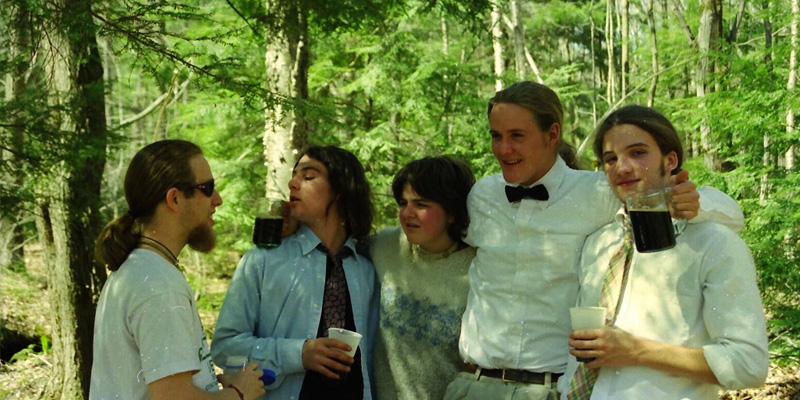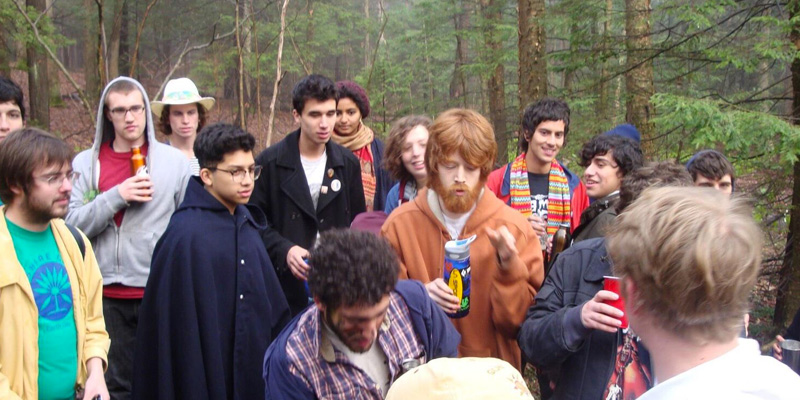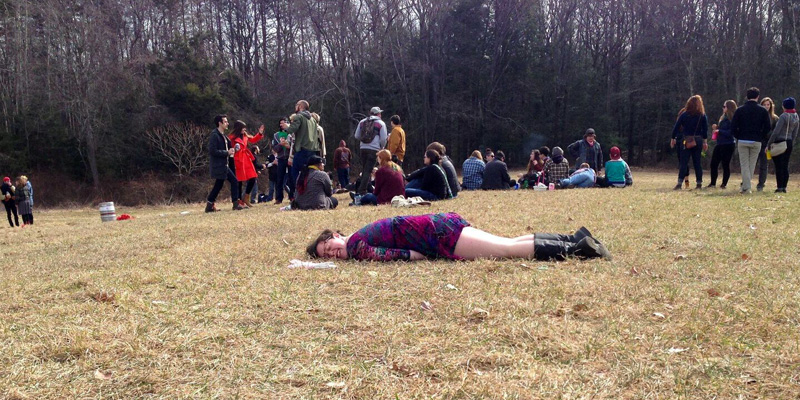It’s 6 in the morning on a chilly Sunday in April. As the sky begins to brighten, a cool mist rolls out of the Berkshire Mountains into the valley, coating the grass with dew. In the town of Amherst, children sleep soundly, dreaming of marshmallows and chocolate and the Easter eggs hidden throughout their homes, soon to be discovered. But down the road at Hampshire College, students are already awake. They’re lacing up their hiking boots and pulling beanies snugly around their ears. They’re grabbing mason jars or coffee mugs or whatever receptacle is at hand, and some of them may be drinking beer already. By 7 o’clock, the sun has risen. The Easter Keg Hunt has begun.
In groups, the students head down the road, past the tennis courts and into the woods. It is a beautiful Massachusetts morning, and as rays of sunlight filter through the pine trees onto the soft forest floor, birds sing loudly to greet the coming of spring. Hampshire students notice none of these things. They are in the woods for a singular purpose: to drink as much beer as possible before noon.
This goal is actually quite realistic. In the days leading up to the Keg Hunt, several organized groups of senior students purchase kegs of beer and haul them into the woods during the wee hours of the night. They have to be careful. Campus police are well aware of this raucous holiday and will stop any students headed into the woods and seize their kegs. Those who make it out stash the kegs behind trees, under rocks, in a brook, up a tree, buried in the dirt, in the middle of a cornfield, or wherever they deem fit. Then, like a herd of boozy Easter bunnies, they scurry back to their warrens until daybreak. In the morning they return, taps in hand, to await the throngs of thirsty students diligently combing the woods.
Don't Miss A Drop
Get the latest in beer, wine, and cocktail culture sent straight to your inbox.For a lot of Hampshire students, the first keg tapped is the most memorable. I can picture clear as day the first one that I ever found, standing alone beneath a pine tree, its metal girth shining like a silver treasure. With the unrestrained enthusiasm of first years, my friends and I had plunged into the woods around 5 a.m., and by the time we discovered this first keg, its owners had yet to arrive. So I tapped it with a stick and squirted foamy beer into my mouth. I probably shouldn’t have done that, but it started off the day right.
Around 9 the hunt really gets going as crowds of buzzing students swarm the few discovered kegs. Like a beacon, the presence of a group signals “BEER!” to oncoming students, who crash through the thicket hoping to fill their cups. By this time there are several hundred people in the woods, and the serenity of early morning is replaced by the sort of drunken chaos usually found at frat parties or football games, but everyone’s wearing flannel and has an alternative haircut.
As the morning carries on students get progressively drunker, muddier and more willing to swallow twigs and dirt along with their beer. It’s not uncommon to find people sprawled out in a stream, or to come across a spontaneous bout of mud wrestling. The keg stand, while quite popular at other colleges, is rarely found at Hampshire, except on Easter Sunday.
One time, a close friend of mine who was especially drunk baptized me in a stream after making what I’m sure he thought was a stirring and profound Easter sermon.
“What’s funny is that it’s this religious holiday that no one takes seriously and now we’ll always associate it with drinking beer at 6 in the morning — that’s such a Hampshire thing to do,” said former student Quinn Berkman.

It’s worth pointing out that Hampshire College is not a big beer-drinking school. We don’t have any sports teams, unless you count Frisbee, and while students imbibe at a rate comparable to other schools, the idea of organized binge drinking is a big turnoff to most of us. So Easter Keg Hunt becomes a special occasion in which students participate in the kind of unrestrained beer-guzzling that is familiar to our neighbors at UMass, but is new and exciting to us.
“We decided we wanted to throw a party and do something big, something totally different than anything that’s been done before,” said Sam Morris, one of the original founders of Easter Keg Hunt. It was 1998 and first year roommates Doug Magda and Adam Thurrell were having a late night semi-drunk discussion in the Merrill A1 dorm over how to execute that goal. “And I said something to the effect of, ‘They have Easter egg hunts, why not an Easter keg hunt?’” Magda recalled. The next day, the roommates shared the idea with their friends over breakfast. “And we were all like ‘holy fuck that’s amazing!’” said Morris. And thus the Easter Keg Hunt was born.
Pooling their money together, enterprising first years Doug Magda, Adam Thurrell, Sam Morris, Michael DiDonna, Andy McKinney, Matt Keenis, Will Sennig, Bill Heiser and Andrea Norman purchased four kegs of beer and used colored paper to decorate them like Easter eggs. “It was all pretty good beer,” said Morris. “No shit beer, that would’ve been against our standards. There was at least one local IPA.”
Around 4:30 in the morning they sneaked the kegs out into the woods and stashed them in places they had scouted out the previous day. At high noon (because the original keg hunters had some degree of self control), Morris donned his Easter bunny costume and assumed his post at the Hampshire tree, a campus meeting place located in a neighboring cornfield, where he had assembled a collection of riddles written on pieces of paper. The riddles contained clues to the whereabouts of the kegs, and as students trickled onto the field he handed them out along with some candy.
“It was all very hidden and well managed,” said Michael DiDonna. “Each of the keg-tenders was wearing nice clothing, like a bow tie, and you were only allowed to have two beers at each keg before you had to move on to the next one.” When participants found a keg, part of a bunny was drawn on their hands, and they couldn’t drink freely until they had completed the drawing. “We put a lot of thought into the clues, and they referenced the type of beer it was, like an ale or IPA,” DiDonna continued, “And the drunker you got, the harder they were to find.”
“Down by the river where we fish for trout, you’ll find a keg of icy cold _____,” read one of the riddles.
But the festivities came to a halt when the local farmer who owned the land drove up in his four-wheeler. “We saw him approaching and thought ‘oh fuck.’ What were we thinking? We totally overlooked the fact that the farmer who owns this land would find out,” Morris recalls. “So I’m standing there in my bunny suit thinking I’m totally busted. He goes, ‘So what are you guys doing out here?’ I decided to be totally honest with him. I said, ‘We hid some kegs out in the woods, and we’re calling it an Easter keg hunt.’ And he says, ‘That’s the greatest goddamn idea I ever heard. Mind if I join ya?’”
Farmer Gordie soon became a core member of the Easter Keg Hunt. The next year, when the founders upped it to eight kegs, they had to use Adam Thurrell’s pickup truck to haul them out but it got stuck in the mud. Gordie pulled up in his tractor and towed them out, thus saving the hunt that year. The story goes that Gordie kept coming back until his wife found out that he wasn’t tending cattle, but spending his Easter in the woods drinking beer with a bunch of college students.
Things have changed since then, and today’s version of the Keg Hunt is less organized than the original. No one gives out clues, for one thing. But people do show up in bunny costumes and hand out treats like plastic eggs filled with pot-laced granola or Jell-O shots, and the tradition has gotten stronger with an attendance rate of at least 500 students drinking 10 to 15 kegs each year. Other aspects remain the same, such as the post-hunt zombie crawl to the dining commons, in which mud-covered keg hunters sober up over coffee and tater tots.

“I feel like the theme of it is really being in the woods with the whole school,” said student Henry Anderson. “The sun rises and it’s a really wholesome time, then everyone gets really drunk and it gets to be a shit show when everyone goes to Saga [the dining commons]. Then there’s always the afternoon nap.”
“I think the administration eventually found out, but they turned a blind eye to it,” Morris said. “As long as no one was getting hurt, and it was technically not on campus, they didn’t bother busting it.” Today, this attitude remains the same. When I reached out to a campus spokesperson for comment, he referred me to the school’s alcohol and drug policy, avoiding any mention of Keg Hunt. And though campus police do attempt to stop students from bringing kegs into the woods, they declined to comment for this article.
Perhaps the strongest reason this tradition has survived is the fact that it exemplifies the true Hampshire spirit: creativity, collective effort and being weird in the woods. For many students, Easter Keg Hunt remains an unforgettable part of their college experience. This is certainly true for Sam Morris.
“In November of 1999, I was in a car accident, which left me paraplegic,” he said. “So I took off the next winter and spring to go through surgery and rehabilitation. And I made my official debut in a wheelchair for Easter Keg Hunt, dressed as the Easter bunny. I wasn’t going to let being paraplegic step in the way of my Keg Hunt.”
“That was super-traumatic for everybody,” Michael DiDonna remembers. “It takes a long time to get used to living in a wheelchair for the rest of your life, and here he is back at school within six months, in his chair in the woods.” In a pure expression of Hampshire spirit, he had rigged it with mountain-bike tires, and the group of friends took turns maneuvering him from keg to keg. Morris would go on to wear his bunny ears at graduation, and today he runs a personal development program called Zen Warrior Training.
Recent graduate Sam Hollier summed it up nicely. “It’s different than all the other times you get drunk with your friends because it’s a game and this big collective activity. It’s more exciting than having a party because you’re not in a dorm room, there are no limits, you can go wherever you want. And it was always sunny at Keg Hunt. It just felt good to be outside.”

